Comprehensive Statistical Analysis of Crime Data: Research Project
VerifiedAdded on 2023/01/11
|7
|1130
|70
Report
AI Summary
This research project presents a statistical analysis of crime data, examining various aspects such as victim demographics, arrest types, and weapon usage. The report begins with an introduction discussing the increasing crime rates in major cities and the measures taken by governments, including the collection and storage of crime data for analysis. The study analyzes data from a sample of 14,188 victims, presenting the distribution of victims' descent by gender, revealing that a majority of victims are of H descent and male. Further analysis explores the distribution of victims by arrest type and area of origin, highlighting that Central had the highest number of victims. The report includes a summary of victim ages, with a mean age of 41.5 years and the presence of outliers. Finally, the distribution of weapons used during crimes is presented, revealing that strong-arm tactics are the most commonly used weapon. The report provides tables, a box and whisker plot, and a graph to illustrate the statistical findings.

Research project
Statistics
Student name:
Tutor name:
1 | P a g e
Statistics
Student name:
Tutor name:
1 | P a g e
Paraphrase This Document
Need a fresh take? Get an instant paraphrase of this document with our AI Paraphraser

Research project
Introduction
Crime in major cities has been very rampant in the recent decade. This has been attributed to
various causes such as the use of drugs by the youth, high unemployment rates and peer
influence (Brewer & Grabosky, 2014). A number of measures have also been put by various
governments to help curb the crimes. One of the major steps adopted by the US government
through department of security to help aid the fight against crime is collecting and storing crime
data in a database for analysis purposes (Higginson & Mazerolle, 2014). The data thus collected
help to identify the most rampant type of crimes and their locations among other things. This has
helped a great deal to curb crimes though with a lot of challenges (Crawford, 2009).
Table of distribution of victims’ descent by gender
GENDER
VICTIM DESCENT F H M X
Grand
Total
A 260 252 512
B 1373 1762 3135
C 3 5 8
F 11 4 15
H 2484 1 3372 5857
I 5 7 12
J 4 1 5
K 19 35 54
O 490 1096 1586
P 3 3 6
W 1093 1804 2897
X 7 26 68 101
Grand Total 5752 1 8367 68 14188
Table 1
The pivot table above shows the distribution of victims’ descent by gender. The number of
victims that were sampled in the data was 14,188 in total. As can be observed from the table
2 | P a g e
Introduction
Crime in major cities has been very rampant in the recent decade. This has been attributed to
various causes such as the use of drugs by the youth, high unemployment rates and peer
influence (Brewer & Grabosky, 2014). A number of measures have also been put by various
governments to help curb the crimes. One of the major steps adopted by the US government
through department of security to help aid the fight against crime is collecting and storing crime
data in a database for analysis purposes (Higginson & Mazerolle, 2014). The data thus collected
help to identify the most rampant type of crimes and their locations among other things. This has
helped a great deal to curb crimes though with a lot of challenges (Crawford, 2009).
Table of distribution of victims’ descent by gender
GENDER
VICTIM DESCENT F H M X
Grand
Total
A 260 252 512
B 1373 1762 3135
C 3 5 8
F 11 4 15
H 2484 1 3372 5857
I 5 7 12
J 4 1 5
K 19 35 54
O 490 1096 1586
P 3 3 6
W 1093 1804 2897
X 7 26 68 101
Grand Total 5752 1 8367 68 14188
Table 1
The pivot table above shows the distribution of victims’ descent by gender. The number of
victims that were sampled in the data was 14,188 in total. As can be observed from the table
2 | P a g e
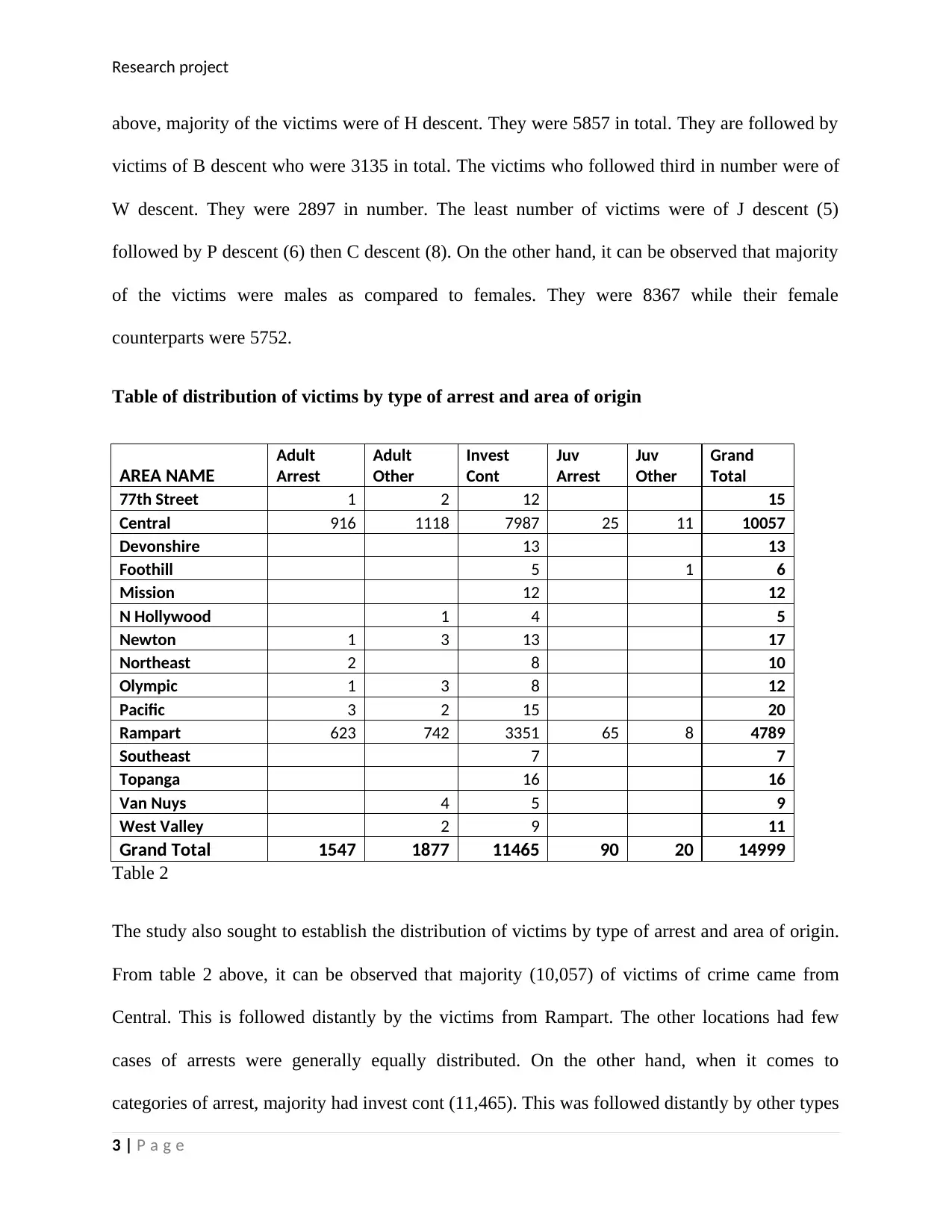
Research project
above, majority of the victims were of H descent. They were 5857 in total. They are followed by
victims of B descent who were 3135 in total. The victims who followed third in number were of
W descent. They were 2897 in number. The least number of victims were of J descent (5)
followed by P descent (6) then C descent (8). On the other hand, it can be observed that majority
of the victims were males as compared to females. They were 8367 while their female
counterparts were 5752.
Table of distribution of victims by type of arrest and area of origin
AREA NAME
Adult
Arrest
Adult
Other
Invest
Cont
Juv
Arrest
Juv
Other
Grand
Total
77th Street 1 2 12 15
Central 916 1118 7987 25 11 10057
Devonshire 13 13
Foothill 5 1 6
Mission 12 12
N Hollywood 1 4 5
Newton 1 3 13 17
Northeast 2 8 10
Olympic 1 3 8 12
Pacific 3 2 15 20
Rampart 623 742 3351 65 8 4789
Southeast 7 7
Topanga 16 16
Van Nuys 4 5 9
West Valley 2 9 11
Grand Total 1547 1877 11465 90 20 14999
Table 2
The study also sought to establish the distribution of victims by type of arrest and area of origin.
From table 2 above, it can be observed that majority (10,057) of victims of crime came from
Central. This is followed distantly by the victims from Rampart. The other locations had few
cases of arrests were generally equally distributed. On the other hand, when it comes to
categories of arrest, majority had invest cont (11,465). This was followed distantly by other types
3 | P a g e
above, majority of the victims were of H descent. They were 5857 in total. They are followed by
victims of B descent who were 3135 in total. The victims who followed third in number were of
W descent. They were 2897 in number. The least number of victims were of J descent (5)
followed by P descent (6) then C descent (8). On the other hand, it can be observed that majority
of the victims were males as compared to females. They were 8367 while their female
counterparts were 5752.
Table of distribution of victims by type of arrest and area of origin
AREA NAME
Adult
Arrest
Adult
Other
Invest
Cont
Juv
Arrest
Juv
Other
Grand
Total
77th Street 1 2 12 15
Central 916 1118 7987 25 11 10057
Devonshire 13 13
Foothill 5 1 6
Mission 12 12
N Hollywood 1 4 5
Newton 1 3 13 17
Northeast 2 8 10
Olympic 1 3 8 12
Pacific 3 2 15 20
Rampart 623 742 3351 65 8 4789
Southeast 7 7
Topanga 16 16
Van Nuys 4 5 9
West Valley 2 9 11
Grand Total 1547 1877 11465 90 20 14999
Table 2
The study also sought to establish the distribution of victims by type of arrest and area of origin.
From table 2 above, it can be observed that majority (10,057) of victims of crime came from
Central. This is followed distantly by the victims from Rampart. The other locations had few
cases of arrests were generally equally distributed. On the other hand, when it comes to
categories of arrest, majority had invest cont (11,465). This was followed distantly by other types
3 | P a g e
⊘ This is a preview!⊘
Do you want full access?
Subscribe today to unlock all pages.

Trusted by 1+ million students worldwide
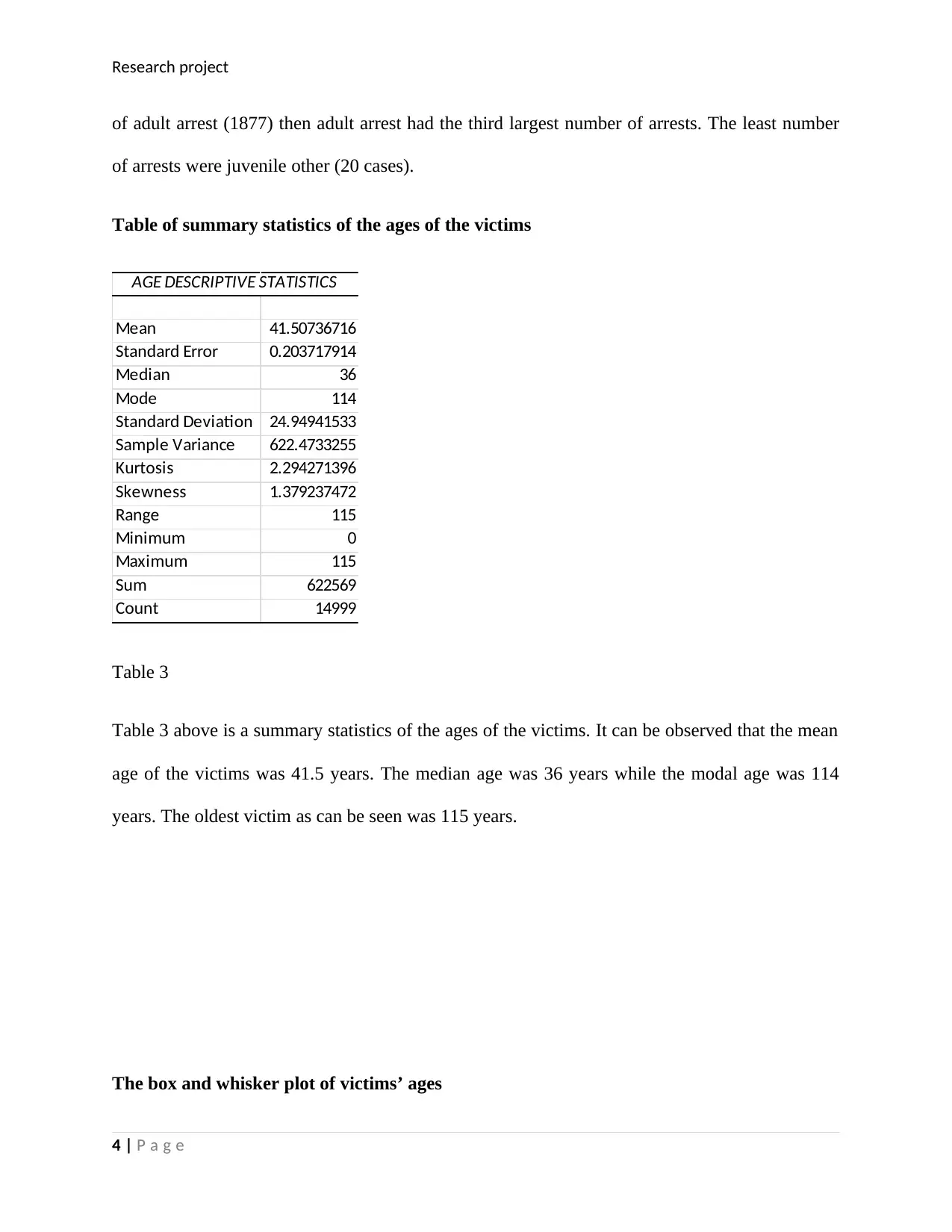
Research project
of adult arrest (1877) then adult arrest had the third largest number of arrests. The least number
of arrests were juvenile other (20 cases).
Table of summary statistics of the ages of the victims
AGE DESCRIPTIVE STATISTICS
Mean 41.50736716
Standard Error 0.203717914
Median 36
Mode 114
Standard Deviation 24.94941533
Sample Variance 622.4733255
Kurtosis 2.294271396
Skewness 1.379237472
Range 115
Minimum 0
Maximum 115
Sum 622569
Count 14999
Table 3
Table 3 above is a summary statistics of the ages of the victims. It can be observed that the mean
age of the victims was 41.5 years. The median age was 36 years while the modal age was 114
years. The oldest victim as can be seen was 115 years.
The box and whisker plot of victims’ ages
4 | P a g e
of adult arrest (1877) then adult arrest had the third largest number of arrests. The least number
of arrests were juvenile other (20 cases).
Table of summary statistics of the ages of the victims
AGE DESCRIPTIVE STATISTICS
Mean 41.50736716
Standard Error 0.203717914
Median 36
Mode 114
Standard Deviation 24.94941533
Sample Variance 622.4733255
Kurtosis 2.294271396
Skewness 1.379237472
Range 115
Minimum 0
Maximum 115
Sum 622569
Count 14999
Table 3
Table 3 above is a summary statistics of the ages of the victims. It can be observed that the mean
age of the victims was 41.5 years. The median age was 36 years while the modal age was 114
years. The oldest victim as can be seen was 115 years.
The box and whisker plot of victims’ ages
4 | P a g e
Paraphrase This Document
Need a fresh take? Get an instant paraphrase of this document with our AI Paraphraser
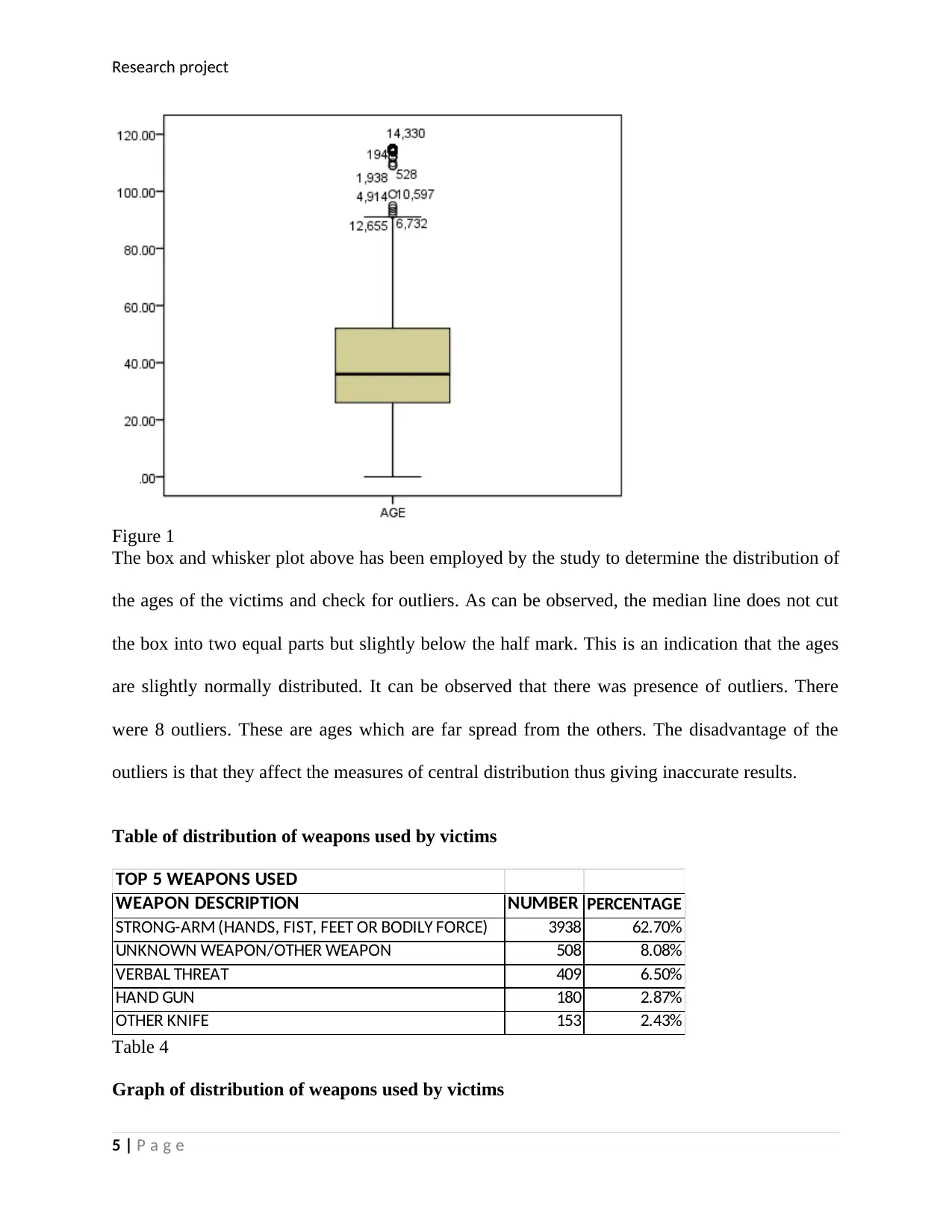
Research project
Figure 1
The box and whisker plot above has been employed by the study to determine the distribution of
the ages of the victims and check for outliers. As can be observed, the median line does not cut
the box into two equal parts but slightly below the half mark. This is an indication that the ages
are slightly normally distributed. It can be observed that there was presence of outliers. There
were 8 outliers. These are ages which are far spread from the others. The disadvantage of the
outliers is that they affect the measures of central distribution thus giving inaccurate results.
Table of distribution of weapons used by victims
TOP 5 WEAPONS USED
WEAPON DESCRIPTION NUMBER PERCENTAGE
STRONG-ARM (HANDS, FIST, FEET OR BODILY FORCE) 3938 62.70%
UNKNOWN WEAPON/OTHER WEAPON 508 8.08%
VERBAL THREAT 409 6.50%
HAND GUN 180 2.87%
OTHER KNIFE 153 2.43%
Table 4
Graph of distribution of weapons used by victims
5 | P a g e
Figure 1
The box and whisker plot above has been employed by the study to determine the distribution of
the ages of the victims and check for outliers. As can be observed, the median line does not cut
the box into two equal parts but slightly below the half mark. This is an indication that the ages
are slightly normally distributed. It can be observed that there was presence of outliers. There
were 8 outliers. These are ages which are far spread from the others. The disadvantage of the
outliers is that they affect the measures of central distribution thus giving inaccurate results.
Table of distribution of weapons used by victims
TOP 5 WEAPONS USED
WEAPON DESCRIPTION NUMBER PERCENTAGE
STRONG-ARM (HANDS, FIST, FEET OR BODILY FORCE) 3938 62.70%
UNKNOWN WEAPON/OTHER WEAPON 508 8.08%
VERBAL THREAT 409 6.50%
HAND GUN 180 2.87%
OTHER KNIFE 153 2.43%
Table 4
Graph of distribution of weapons used by victims
5 | P a g e
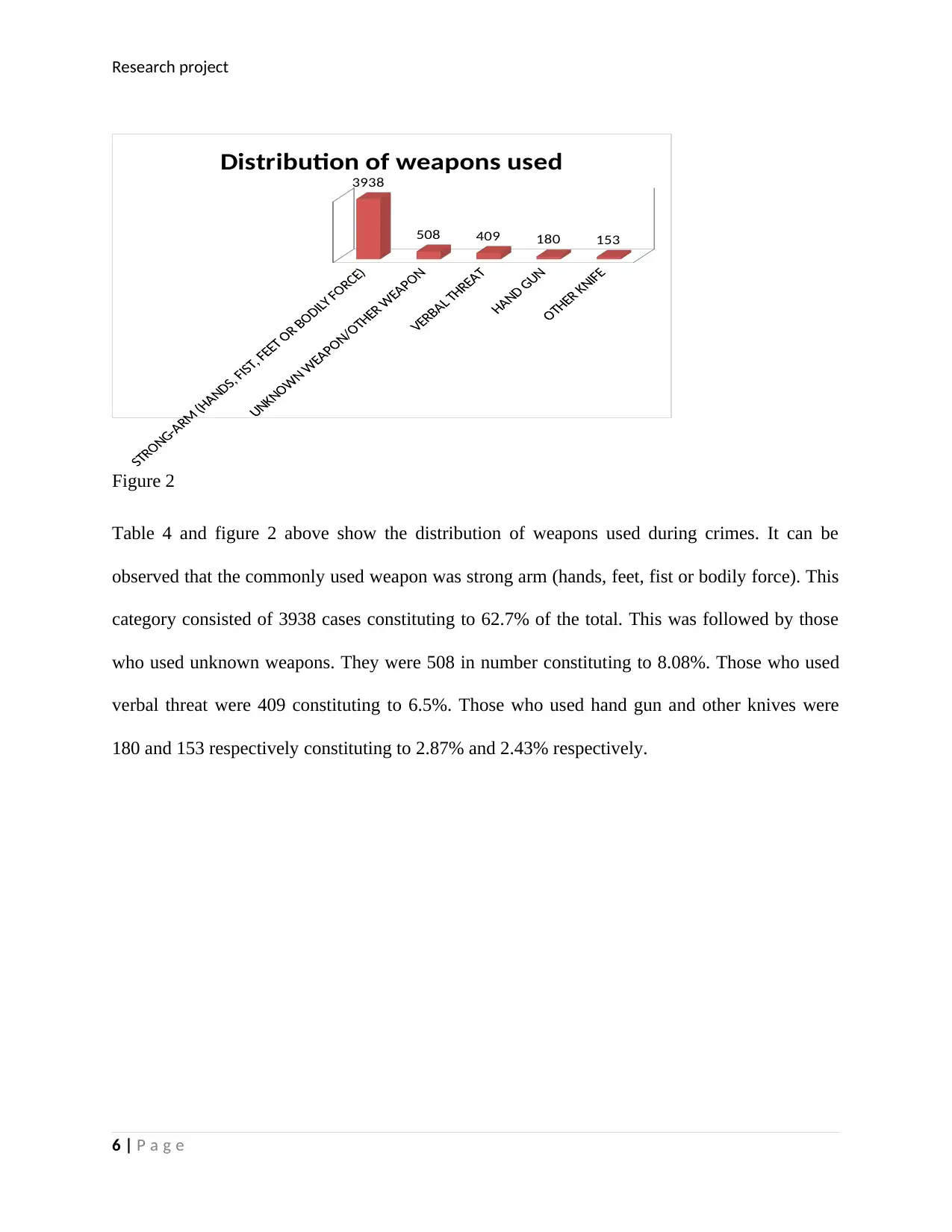
Research project
3938
508 409 180 153
Distribution of weapons used
Figure 2
Table 4 and figure 2 above show the distribution of weapons used during crimes. It can be
observed that the commonly used weapon was strong arm (hands, feet, fist or bodily force). This
category consisted of 3938 cases constituting to 62.7% of the total. This was followed by those
who used unknown weapons. They were 508 in number constituting to 8.08%. Those who used
verbal threat were 409 constituting to 6.5%. Those who used hand gun and other knives were
180 and 153 respectively constituting to 2.87% and 2.43% respectively.
6 | P a g e
3938
508 409 180 153
Distribution of weapons used
Figure 2
Table 4 and figure 2 above show the distribution of weapons used during crimes. It can be
observed that the commonly used weapon was strong arm (hands, feet, fist or bodily force). This
category consisted of 3938 cases constituting to 62.7% of the total. This was followed by those
who used unknown weapons. They were 508 in number constituting to 8.08%. Those who used
verbal threat were 409 constituting to 6.5%. Those who used hand gun and other knives were
180 and 153 respectively constituting to 2.87% and 2.43% respectively.
6 | P a g e
⊘ This is a preview!⊘
Do you want full access?
Subscribe today to unlock all pages.

Trusted by 1+ million students worldwide
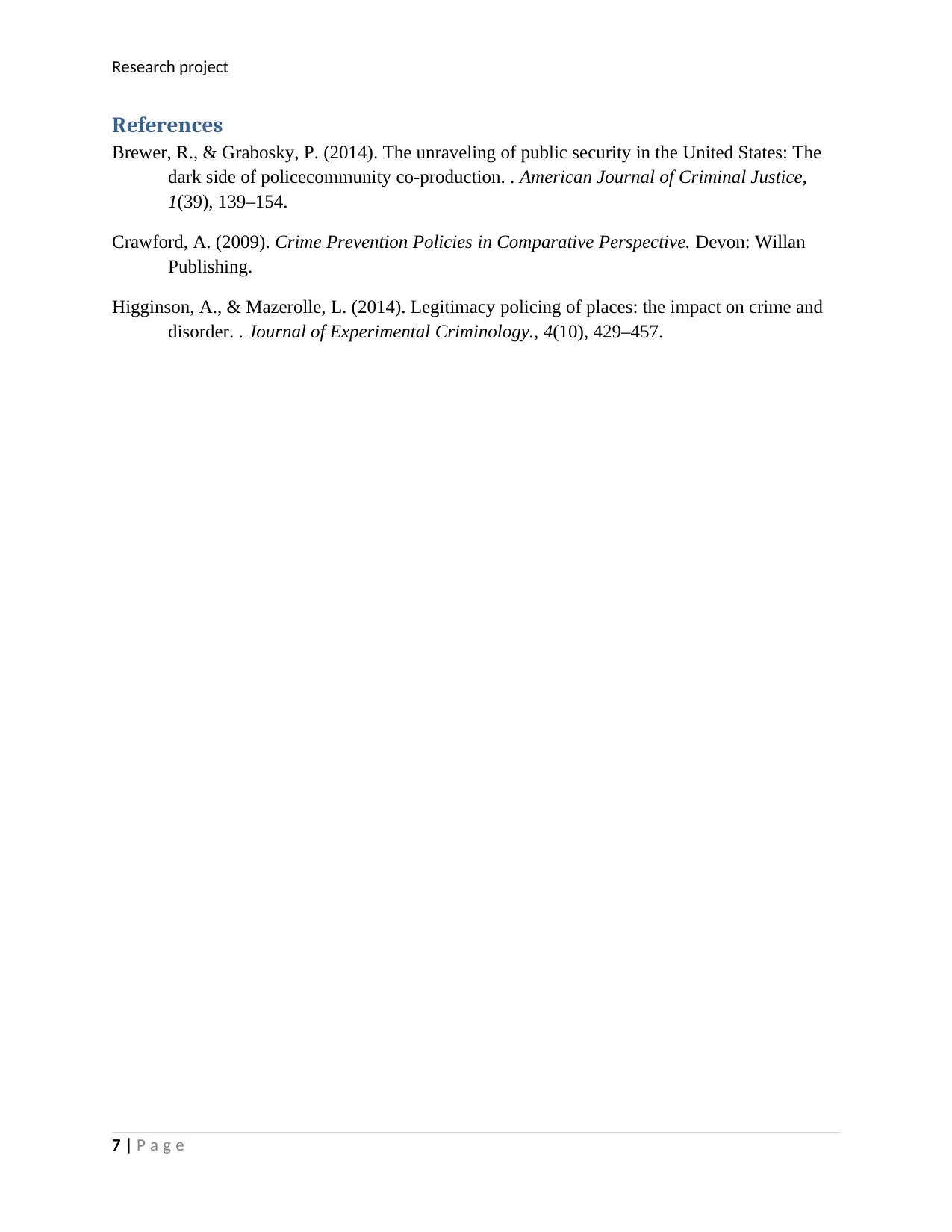
Research project
References
Brewer, R., & Grabosky, P. (2014). The unraveling of public security in the United States: The
dark side of policecommunity co-production. . American Journal of Criminal Justice,
1(39), 139–154.
Crawford, A. (2009). Crime Prevention Policies in Comparative Perspective. Devon: Willan
Publishing.
Higginson, A., & Mazerolle, L. (2014). Legitimacy policing of places: the impact on crime and
disorder. . Journal of Experimental Criminology., 4(10), 429–457.
7 | P a g e
References
Brewer, R., & Grabosky, P. (2014). The unraveling of public security in the United States: The
dark side of policecommunity co-production. . American Journal of Criminal Justice,
1(39), 139–154.
Crawford, A. (2009). Crime Prevention Policies in Comparative Perspective. Devon: Willan
Publishing.
Higginson, A., & Mazerolle, L. (2014). Legitimacy policing of places: the impact on crime and
disorder. . Journal of Experimental Criminology., 4(10), 429–457.
7 | P a g e
1 out of 7
Related Documents
Your All-in-One AI-Powered Toolkit for Academic Success.
+13062052269
info@desklib.com
Available 24*7 on WhatsApp / Email
![[object Object]](/_next/static/media/star-bottom.7253800d.svg)
Unlock your academic potential
© 2024 | Zucol Services PVT LTD | All rights reserved.




